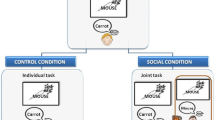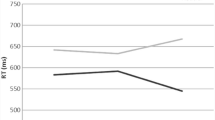Abstract
People working together on a task must often represent the goals and salient items of their partner. The aim of the present study was to study the influence of joint task representations in an interference task in which the congruency relies on semantic identity. If task representations are shared between partners in a joint Stroop task (co-representation account), we hypothesized that items in the response set of one partner might influence performance of the other. In Experiment 1, pairs of participants sat side by side. Each participant was instructed to press one of two buttons to indicate which of two colors assigned to them was present, ignoring the text and responding only to the pixel color. There were three types of incongruent distractor words: names of colors from their own response set, names of colors from the other partner’s response set, and neutral words for colors not used as font colors. The results of Experiment 1 showed that when people were doing this task together, distractor words from the partner’s response set interfered more than neutral words and just as much as the words from their own response color set. However, in three follow-up experiments (Experiments 2a, 2b, and 2c), we found an elevated interference for the other response-set words even though no co-actor was present. The overall pattern of results across our study suggests that an alternative response set, regardless of whether it belonged to a co-actor or to a non-social no-go condition, evoked equal amounts of interference comparable to those of the own response set. Our findings are in line with a theory of common coding, in which all events—irrespective of their social nature—are represented and can influence behavior.



Similar content being viewed by others
References
Atmaca, S., Sebanz, N., & Knoblich, G. (2011). The joint flanker effect: sharing tasks with real and imagined co-actors. Experimental Brain Research, 211(3–4), 371–385. doi:10.1007/s00221-011-2709-9.
Augustinova, M., & Ferrand, L. (2012). The influence of mere social presence on Stroop interference: new evidence from the semantically-based Stroop task. Journal of Experimental Social Psychology, 48(5), 1213–1216. doi:10.1016/j.jesp.2012.04.014.
Böckler, A., Knoblich, G., & Sebanz, N. (2012). Effects of a coactor’s focus of attention on task performance. Journal of Experimental Psychology: Human Perception and Performance, 38(6), 1404–1415. doi:10.1037/a0027523.
Box, G. E. P., & Cox, D. R. (1964). An Analysis of Transformations. Journal of the Royal Statistical Society: Series B (Methodological), 26(2), 211–252.
Demiral, Ş. B., Gambi, C., Nieuwland, M. S., & Pickering, M. J. (2016). Neural correlates of verbal joint action: ERPs reveal common perception and action systems in a shared-Stroop task. Brain Research, 1649((Pt A)), 79–89. doi:10.1016/j.brainres.2016.08.025.
Dittrich, K., Bossert, M.-L., Rothe-Wulf, A., & Klauer, K. C. (2017). The joint flanker effect and the joint Simon effect: on the comparability of processes underlying joint compatibility effects. The Quarterly Journal of Experimental Psychology, 70(9), 1808–1823. doi:10.1080/17470218.2016.1207690.
Dittrich, K., Dolk, T., Rothe-Wulf, A., Klauer, K. C., & Prinz, W. (2013). Keys and seats: spatial response coding underlying the joint spatial compatibility effect. Attention, Perception, & Psychophysics, 75(8), 1725–1736. doi:10.3758/s13414-013-0524-z.
Dittrich, K., Rothe, A., & Klauer, K. C. (2012). Increased spatial salience in the social Simon task: a response-coding account of spatial compatibility effects. Attention, Perception & Psychophysics, 74(5), 911–929. doi:10.3758/s13414-012-0304-1.
Dolk, T., Hommel, B., Colzato, L. S., Schutz-Bosbach, S., Prinz, W., & Liepelt, R. (2014a). The joint Simon effect a review and theoretical integration. Frontiers in Psychology. doi:10.3389/Fpsyg.2014.00974.
Dolk, T., Hommel, B., Colzato, L. S., Schütz-Bosbach, S., Prinz, W., & Liepelt, R. (2011). How “Social” is the social Simon effect? Frontiers in Psychology. doi:10.3389/fpsyg.2011.00084.
Dolk, T., Hommel, B., Prinz, W., & Liepelt, R. (2013). The (not so) social simon effect: a referential coding account. Journal of Experimental Psychology-Human Perception and Performance, 39(5), 1248–1260. doi:10.1037/a0031031.
Dolk, T., Hommel, B., Prinz, W., & Liepelt, R. (2014b). The joint flanker effect: less social than previously thought. Psychonomic Bulletin & Review, 21(5), 1224–1230. doi:10.3758/s13423-014-0583-8.
Egner, T. (2007). Congruency sequence effects and cognitive control. Cognitive, Affective & Behavioral Neuroscience, 7(4), 380–390.
Frischen, A., Loach, D., & Tipper, S. P. (2009). Seeing the world through another person’s eyes: simulating selective attention via action observation. Cognition, 111(2), 212–218. doi:10.1016/j.cognition.2009.02.003.
Guerin, B. (1983). Social facilitation and social monitoring: a test of three models. British Journal of Social Psychology, 22(3), 203–214. doi:10.1111/j.2044-8309.1983.tb00585.x.
Hommel, B. (2009). Action control according to TEC (theory of event coding). Psychological Research, 73(4), 512–526. doi:10.1007/s00426-009-0234-2.
Hommel, B., Colzato, L. S., & van den Wildenberg, W. P. M. (2009). How Social Are Task Representations? Psychological Science, 20(7), 794–798. doi:10.1111/j.1467-9280.2009.02367.x.
Hommel, B., Müsseler, J., Aschersleben, G., & Prinz, W. (2001). The theory of event coding (TEC): a framework for perception and action planning. The Behavioral and Brain Sciences, 24(5), 849–878. (discussion 878-937).
Huguet, P., Dumas, F., & Monteil, J.-M. (2004). Competing for a desired reward in the stroop task: when attentional control is unconscious but effective versus conscious but ineffective. Canadian Journal of Experimental Psychology/Revue Canadienne de Psychologie Expérimentale, 58(3), 153–167. doi:10.1037/h0087441.
Huguet, P., Galvaing, M. P., Monteil, J. M., & Dumas, F. (1999). Social presence effects in the Stroop task: further evidence for an attentional view of social facilitation. Journal of Personality and Social Psychology, 77(5), 1011.
Klein, G. S. (1964). Semantic power measured through the interference of words with color-naming. The American Journal of Psychology, 77(4), 576–588. doi:10.2307/1420768.
Knoblich, G., Butterfill, S., & Sebanz, N. (2011). Psychological research on joint action: theory and data. Psychology of Learning and Motivation: Advances in Research and Theory, 54(54), 59–101. doi:10.1016/B978-0-12-385527-5.00003-6.
Kornblum, S., Hasbroucq, T., & Osman, A. (1990). Dimensional overlap: cognitive basis for stimulus-response compatibility—a model and taxonomy. Psychological Review, 97(2), 253–270.
Krebs, R. M., Boehler, C. N., & Woldorff, M. G. (2010). The influence of reward associations on conflict processing in the Stroop task. Cognition, 117(3), 341–347. doi:10.1016/j.cognition.2010.08.018.
Lamers, M. J. M., Roelofs, A., & Rabeling-Keus, I. M. (2010). Selective attention and response set in the Stroop task. Memory & Cognition, 38(7), 893–904. doi:10.3758/MC.38.7.893.
Liefooghe, B. (2016). Joint task switching. Journal of Cognitive Psychology, 28(1), 60–78. doi:10.1080/20445911.2015.1084311.
Lien, M.-C., Pedersen, L., & Proctor, R. W. (2016). Stimulus-response correspondence in go-nogo and choice tasks: are reactions altered by the presence of an irrelevant salient object? Psychological Research, 80(6), 912–934. doi:10.1007/s00426-015-0699-0.
Liepelt, R., Wenke, D., Fischer, R., & Prinz, W. (2011). Trial-to-trial sequential dependencies in a social and non-social Simon task. Psychological Research, 75(5), 366–375. doi:10.1007/s00426-010-0314-3.
MacLeod, C. M. (1991). Half a century of research on the Stroop effect: an integrative review. Psychological Bulletin, 109(2), 163–203. doi:10.1037/0033-2909.109.2.163.
Mathôt, S., Schreij, D., & Theeuwes, J. (2012). OpenSesame: an open-source, graphical experiment builder for the social sciences. Behavior Research Methods, 44(2), 314–324. doi:10.3758/s13428-011-0168-7.
Memelink, J., & Hommel, B. (2013). Intentional weighting: a basic principle in cognitive control. Psychological Research, 77(3), 249–259. doi:10.1007/s00426-012-0435-y.
Müller, B. C. N., Brass, M., Kühn, S., Tsai, C.-C., Nieuwboer, W., Dijksterhuis, A., & van Baaren, R. B. (2011). When Pinocchio acts like a human, a wooden hand becomes embodied. Action co-representation for non-biological agents. Neuropsychologia, 49(5), 1373–1377. doi:10.1016/j.neuropsychologia.2011.01.022.
Neely, J. H., & Kahan, T. A. (2001). Is semantic activation automatic? A critical re-evaluation. In H. L. Roediger, J. S. Nairne, I. Neath, & A. M. Surprenant (Eds.), The nature of remembering: Essays in honor of Robert G. Crowder (pp. 69–93). Washington, DC: US: American Psychological Association. doi:10.1037/10394-005.
Prinz, W. (1990). Relationships between perception and action. In D. O. Neumann & P. D. W. Prinz (Eds.), A common coding approach to perception and action. Berlin: Springer. doi:10.1007/978-3-642-75348-0_7.
Prinz, W. (1997). Perception and Action Planning. European Journal of Cognitive Psychology, 9(2), 129–154. doi:10.1080/713752551.
Prinz, W. (2015). Task representation in individual and joint settings. Frontiers in Human Neuroscience. doi:10.3389/fnhum.2015.00268.
Scheibe, K. E., Shaver, P. R., & Carrier, S. C. (1967). Color association values and response interference on variants of the Stroop test. Acta Psychologica, 26, 286–295. doi:10.1016/0001-6918(67)90028-5.
Sebanz, N., Bekkering, H., & Knoblich, G. (2006). Joint action: bodies and minds moving together. Trends in Cognitive Sciences, 10(2), 70–76. doi:10.1016/j.tics.2005.12.009.
Sebanz, N., & Knoblich, G. (2009). Prediction in joint action: what, when, and where. Topics in Cognitive Science, 1(2), 353–367. doi:10.1111/j.1756-8765.2009.01024.x.
Sebanz, N., Knoblich, G., & Prinz, W. (2003). Representing others’ actions: just like one’s own? Cognition, 88(3), B11–B21. doi:10.1016/S0010-0277(03)00043-X.
Sebanz, N., Knoblich, G., & Prinz, W. (2005). How two share a task: corepresenting stimulus-response mappings. Journal of Experimental Psychology: Human Perception and Performance, 31(6), 1234–1246. doi:10.1037/0096-1523.31.6.1234.
Sebanz, N., Voinov, P., & Knoblich, G. (2015). Spatial perspective taking in the context of joint action. Cognitive Processing, 16, S25-S25.
Sellaro, R., Dolk, T., Colzato, L. S., Liepelt, R., & Hommel, B. (2015). Referential coding does not rely on location features: evidence for a nonspatial joint Simon effect. Journal of Experimental Psychology-Human Perception and Performance, 41(1), 186–195. doi:10.1037/a0038548.
Sharma, D., Booth, R., Brown, R., & Huguet, P. (2010). Exploring the temporal dynamics of social facilitation in the Stroop task. Psychonomic Bulletin & Review, 17(1), 52–58. doi:10.3758/PBR.17.1.52.
Stenzel, A., Chinellato, E., Tirado, A., del Pobil, Á. P., Lappe, M., & Liepelt, R. (2012). When humanoid robots become human-like interaction partners: corepresentation of robotic actions. Journal of Experimental Psychology: Human Perception and Performance, 38(5), 1073–1077. doi:10.1037/a0029493.
Stock, A., & Stock, C. (2004). A short history of ideo-motor action. Psychological Research, 68(2–3), 176–188. doi:10.1007/s00426-003-0154-5.
Stroop, R. J. (1935). Studies of interference in serial verbal reactions. Journal of Experimental Psychology, 18(6), 643–662. doi:10.1037/h0054651.
Tsai, C. C., & Brass, M. (2007). Does the human motor system simulate Pinocchio’s actions? Coacting with a human hand versus a wooden hand in a dyadic interaction. Psychological Science, 18(12), 1058–1062. doi:10.1111/j.1467-9280.2007.02025.x.
Tsai, C. C., Kuo, W.-J., Hung, D. L., & Tzeng, O. J. L. (2008). Action co-representation is tuned to other humans. Journal of Cognitive Neuroscience, 20(11), 2015–2024. doi:10.1162/jocn.2008.20144.
van Schie, H. T., van Waterschoot, B. M., & Bekkering, H. (2008). Understanding action beyond imitation: reversed compatibility effects of action observation in imitation and joint action. Journal of Experimental Psychology: Human Perception and Performance, 34(6), 1493–1500. doi:10.1037/a0011750.
Verbruggen, F., & Logan, G. D. (2008). Automatic and controlled response inhibition: associative Learning in the go/no-go and stop-signal paradigms. Journal of Experimental Psychology: General, 137(4), 649–672.
Vlainic, E., Liepelt, R., Colzato, L. S., Prinz, W., & Hommel, B. (2010). The virtual co-actor: the social Simon effect does not rely on online feedback from the other. Frontiers in Psychology, 1, 208. doi:10.3389/fpsyg.2010.00208.
Warren, R. E. (1972). Stimulus encoding and memory. Journal of Experimental Psychology, 94(1), 90.
Warren, R. E. (1974). Association, directionality, and stimulus encoding. Journal of Experimental Psychology, 102(1), 151.
Welsh, T. N., Higgins, L., Ray, M., & Weeks, D. J. (2007). Seeing vs. believing: is believing sufficient to activate the processes of response co-representation? Human Movement Science, 26(6), 853–866. doi:10.1016/j.humov.2007.06.003.
Acknowledgements
The research was funded by the Autonomous Province of Trento, Call “Grandi Progetti 2012”, project “Characterizing and improving brain mechanisms of attention—ATTEND”. The authors report no conflict of interests. We thank Maria Paraskevopoulou and Claudia Bonmassar for the assistance in data collection.
Author information
Authors and Affiliations
Corresponding author
Rights and permissions
About this article
Cite this article
Saunders, D.R., Melcher, D. & van Zoest, W. No evidence of task co-representation in a joint Stroop task. Psychological Research 83, 852–862 (2019). https://doi.org/10.1007/s00426-017-0909-z
Received:
Accepted:
Published:
Issue Date:
DOI: https://doi.org/10.1007/s00426-017-0909-z




